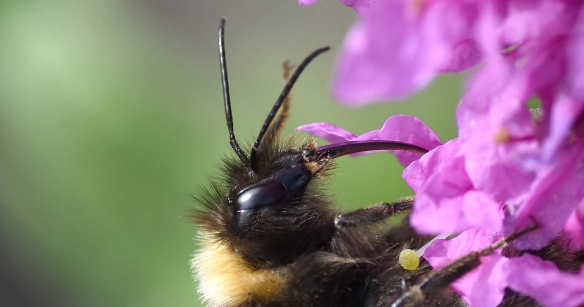Louise Summers, Chair of Luncarty in Bloom, provides today’s guest blog. Luncarty, just north of Perth, has seen a popular community group invest in a variety of planters (and considerable time) to add a splash of floral colour to this popular village. This has also been a welcome addition for pollinators. Here Louise talks through how the group came into being and offers advice for any villages tempted to follow in Luncarty’s footsteps.

Louise, your group has transformed the public spaces and verges in Luncarty. What was the inspiration for taking this work on ?
A few of us saw there was nothing in the common areas of the village apart from grass and wanted to add colour and brighten up the village. Iain Matheson and Alex Cook were founder members and Lyn Mackintosh and myself attended a council meeting, mainly to discuss road safety and by the end of the meeting had somehow got ourselves enrolled into Luncarty in Bloom! We had no idea that the group existed prior to the meeting and decided to try and promote the group and get it better established. Luncarty has a great community spirit and we knew local people would get on board. Now we have a popular Facebook page and it’s fair to say most people in the village know about us!

There must be a fair amount of work in looking after so many containers. How big a time commitment is keeping Luncarty in bloom ?
It might surprise folk to learn that our main core of helpers, is only 6 people! 3 retirees and 3 working mums! It can be difficult fitting it all in, but we all enjoy it and work well as a team. In busy periods such as planting and watering seasons, we rely on the power of Facebook to call on local people to assist. So far we have been lucky with ample volunteers helping to plant bulbs, joining us on litter picks, dedicated waterers etc. The boys in the photo even found a £5 note on the litter pick, so were very chuffed!

You have a range of plants on show. How did you go about picking which species to plant?
One of our group, Nicola MacNee is a trained horticulturist and we rely on her to pick the plants for our displays. These are her comments below!
- We are aware that insects generally are under threat so we knew that any planting we could do would likely help pollinating insects.
- We chose the plants initially for their tolerance of the Scottish weather and irregular watering. We wanted a long flowering season but we have tried to mix up the varieties to get a good range of plants.
- We are aware that we needed to include a lot of single flowering plants for insect life (Begonias give a great show but are all doubles so not good for pollinators)
- This year we chose a much broader range of plants to try to get more insect friendly plants in the mix. We also grew them from plugs instead of buying in well grown plants, this allowed us to choose from a bigger range of plants.
- We hope to establish some wildflower meadow areas in the future
Other villages might like to follow your lead … what advice would you give them ?
Go for it. Initially when we started, we had limited funds and could only manage to fill a few old whisky barrels! 3 years later we have expanded into 3 tiered containers, barrier baskets, recycled containers and even 6 benches!!
We had the confidence to enter ‘Take a Pride in Perthshire’ last year and won Best Newcomer and got Silver award in the Large Village category! We did not expect this at all, but the recognition definitely spurs us on to keep up the momentum. It’s amazing that, after a while, more ideas come to mind, and looking at what other groups do is a great way to get inspiration. At the same time, don’t be overwhelmed by other groups results! Some have been established for a long time but remember, they all started small! That could be your village in the future!!

Any funny tales to tell along the way?
We entered the local Scarecrow competition organised by Luncarty Primary School. One of our entries named ‘OOF’ made the “Courier” and created a lot of laughs in the village. Our other entry — Flora L Bouquet — stood on the main road greeting motorists driving through the village. While ‘OOF’ was fun, Flora was very colourful and flowery attracting insects as well as looks!
Does it cost a lot to plant as much as you have in a village?
The cost is relatively cheap as we all give our time for free and often other bits and pieces. The main costs are plants, which we’ve cheapened by buying plugs this year, bone meal and compost. We were donated winter pansies and primula last year – hope we manage the same again this year! Plants come from Nurseries organised through a Council contract. The Council gives us a small grant annually which covers the cost of plants. Paying for the one-off costs such as buying display planters is expensive and has been achieved through grants.
This year we have been really lucky in winning funding from Tesco’s Bags of Help scheme and also funding from a council-run initiative for local community groups. We also ask local business to donate where possible. In return we display their name on the planters and give them a wee mention on Facebook!!
Recently we had a visit from Scotland’s Deputy First Minister, John Swinney. He says he has noticed the displays on his way home and was impressed with our work! A bit of fame for us at last!
Find out more:
Our Facebook page is https://www.facebook.com/luncartyredgortoninbloom if you want to have look.





















